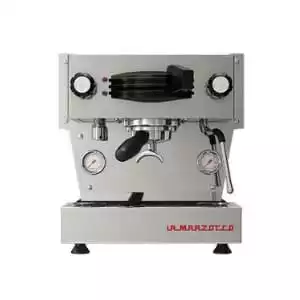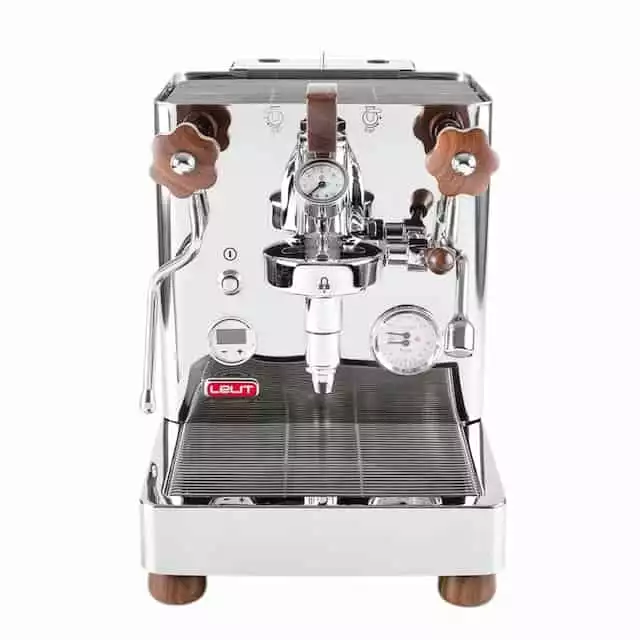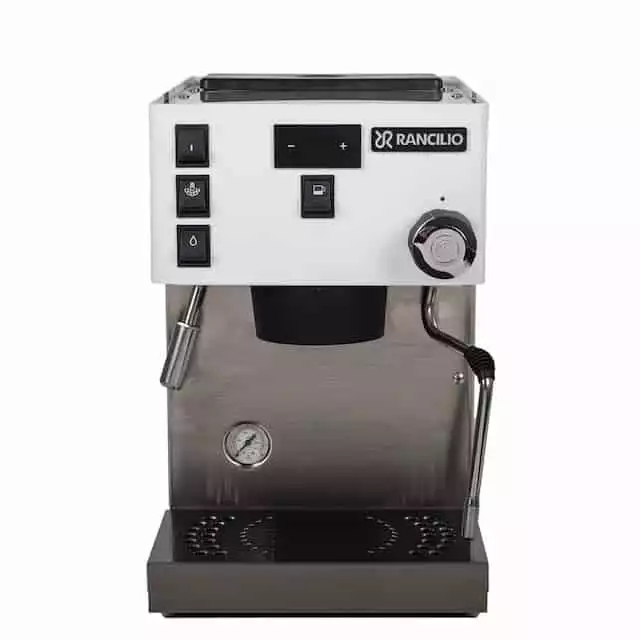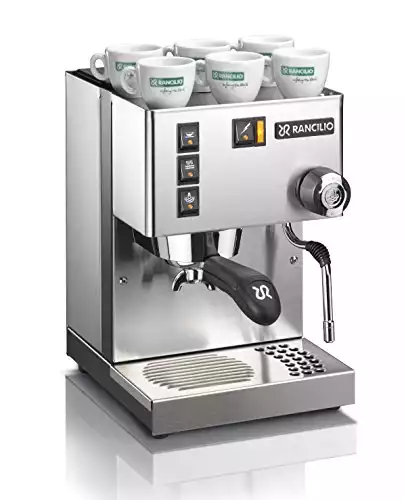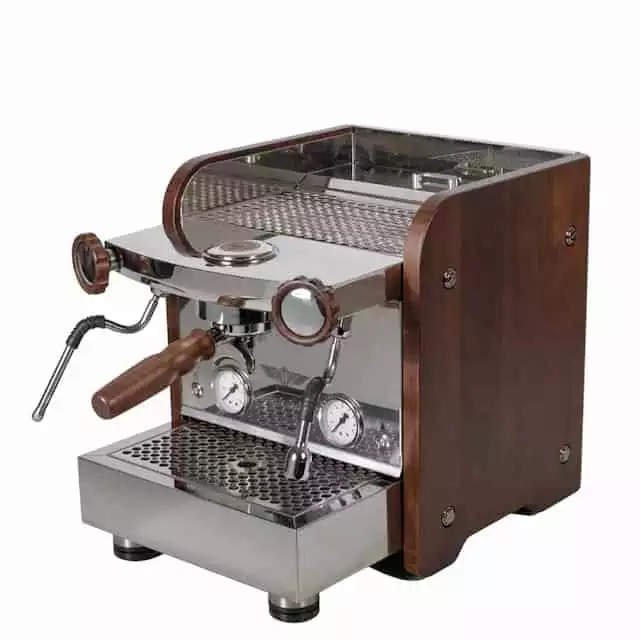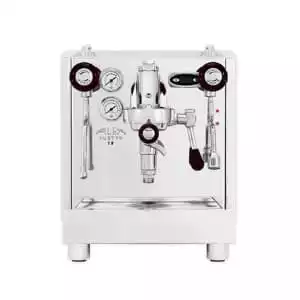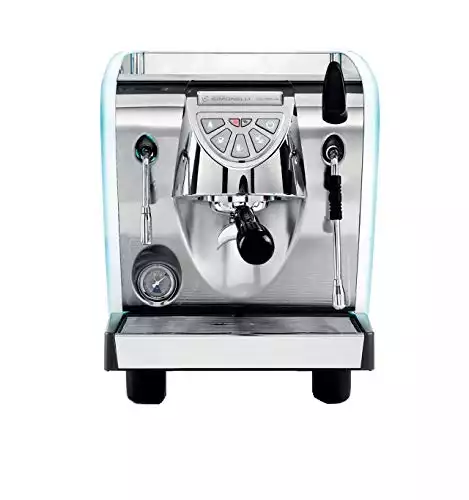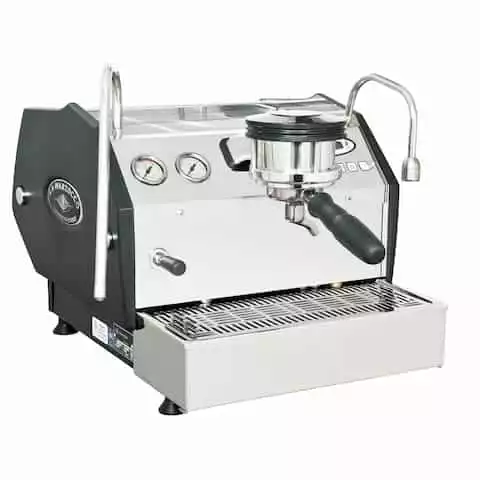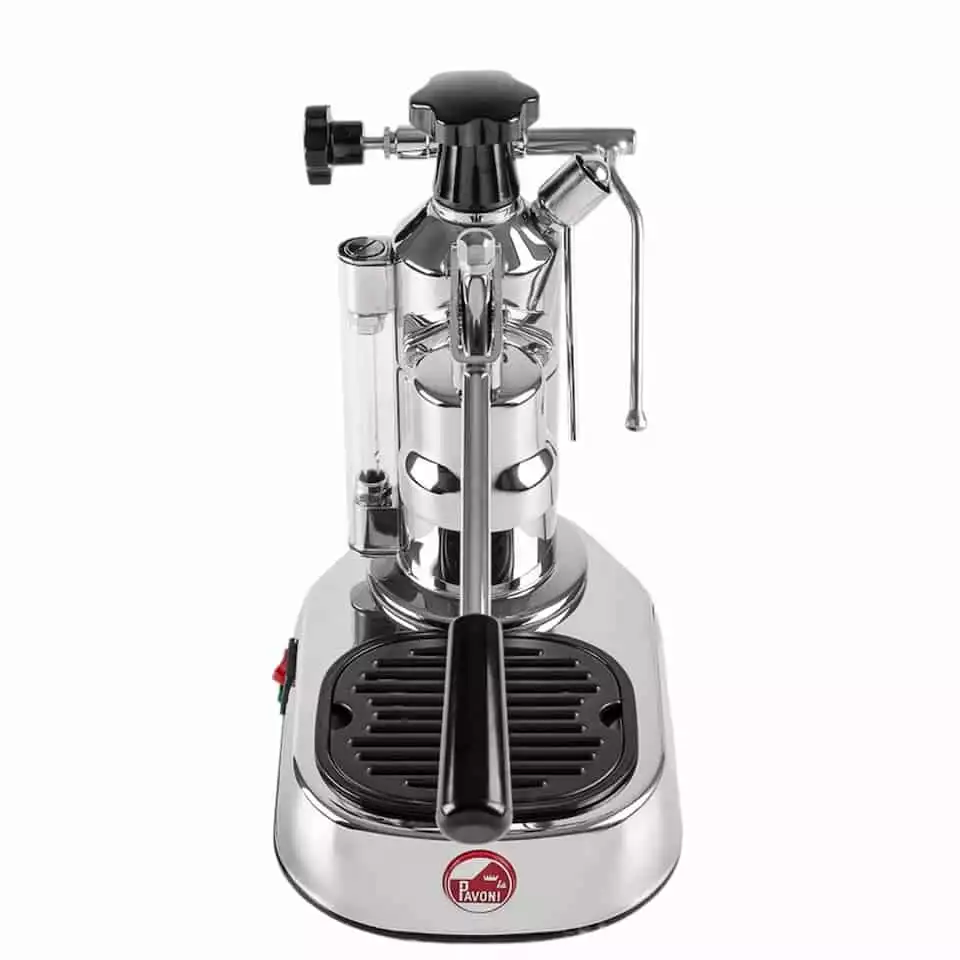Best Prosumer Espresso Machine 2024
Sure, you’re a pro with your coffee gear at home.
But are you PRO-sumer good?
Even the most sophisticated, most knowledgeable espresso lover can only be so good with the wrong equipment. That’s where prosumer espresso machines come in.
Ever wish your shots tasted more like Italy and less like Folgers? A professional-quality, and home kitchen-friendly, prosumer espresso machine is all you need to make that happen.
I’ve used my expertise gained during my years as a (now ex) barista to list out the best prosumer espresso machines in 2024.
Somewhere on this list is the espresso machine that will have you asking the cat, “Single or double?”
- Dual boiler with rapid heat up
- Smart enabled (Bluetooth/WiFi)
- Highly versatile
- Pro-Beginner friendly
- Quiet
- 3 year warranty
- Dual boiler + PID
- Rapid heat time
- Powerful steam wand
The 9 Best Prosumer Espresso Machines in 2024
Prosumer espresso machines are professional-grade equipment for the home barista.
They’re almost as good as the fancy toys you see on the other side of a coffee bar. And just like the “real thing,” prosumer espresso machines also come with built-in steaming capabilities.
So if commercial machines are giving you coffee envy, dive in and find the best prosumer machine for your kitchen.
1. La Marzocco Linea Mini
The Linea Mini is truly a high-end espresso machine that looks — and performs — like the one at your favorite coffee shop.
- Dual boiler with rapid heat up
- Smart enabled (Bluetooth/WiFi)
- Highly versatile
PROS (+)
- PID dual boiler
- 1-second pre-infusion stage
- Includes all needed accessories
CONS (-)
- 10-15 minute warm-up time
- Commercial machine price
How It Works: The Linea Mini is mostly automatic. Simply switch the manual paddle on or off to brew. Dials help you adjust the steam wand and brewing temperature. Although not ideal for absolute beginners, it’s automatic enough to accommodate most.
The Good
La Marzocco’s Linea line is popular in commercial settings; the Mini is the younger sister of the line. But it’s still a powerful espresso machine.
The Linea Mini is a dual boiler machine with a separate brew boiler for brewing coffee and steam boiler for steaming milk. It features an integrated grouphead that offers this temperature stability in a petite space (you’re welcome, limited counter space).
It has PID temperature control, which means the machine will automatically regulate the brewing (and steaming) temperature to keep it optimal for extraction. That guarantees consistent, delicious results.
This automatic espresso machine comes with an adjustment wheel for the double boiler, too, so if you like having more brew flow control, you’ve got it here.
There’s also a pre-infusion setting, which soaks the coffee grounds evenly in the portafilter for one second, also ensuring better extraction and flavor.
PID control and pre-infusion are two essential steps to help you go pro on your home espresso machine.
It features pretty impressive steam power, too, thanks to its surprisingly large steam boiler. As a larger steam boiler, it will also regulate temperature better, creating better results.
Your aesthetic can go pro, too. In addition to finish options for the machine (sleek black, red, or white), you can choose a maple or walnut wood finish on the grouphead cover, portafilter handle, and steam knob.
PLUS, you can choose longer or shorter legs for your machine.
The Linea Mini also comes with single and double grounds baskets, a 12 oz milk pitcher for steaming, a tamper, cleaning powder, and a water test kit. The 58 mm portafilter is also made of commercial-grade steel.
That’s all the equipment you need to make top-quality espresso at home.
As another fun bonus, the Linea Mini is bluetooth and wifi compatible with the La Marzocco Home app.
You can turn it on/off remotely, go on stand-by, set pre-infusion, watch tutorials, and check stats like the boiler temperature or shot counter. You can even control both boiler temperatures.
The Bad
So what’s the downside of an incredible, professional-quality machine?
Well, for one thing, the Linea Mini costs about the same as a commercial espresso machine. The model I was trained on (Tanya R. by Astoria, with two groupheads and steam wands) goes for a little more.
That probably means your espresso will be exceptional. But it also means you could probably buy a latte at a shop every day and at least break even. The Linea Mini is a great option for convenience and enjoyment, not so much for saving money.
Also a bummer: the machine takes a full 10-15 minutes to warm up, just like a commercial model.
2. Lelit Bianca PID V2
The Bianca is a popular machine for good reason, a top-notch choice for beginners and pros alike.
- Pro-Beginner friendly
- Quiet
- 3 year warranty
PROS (+)
- Semi-automatic PID machine
- Direct water line hookup
- Repositionable water reservoir
CONS (-)
- Inner parts could be higher quality
- No warning when the water level low
How It Works: As a semi-automatic model, this entry-level espresso machine is easy to operate with a variable flow paddle.
The Good
This dual boiler machine is surprisingly beginner-friendly for such a quality machine.
It’s semi-automatic, which means it does most of the work for you. You have to control the water flow when pulling shots, but that’s easy to learn, and in time you’ll likely appreciate the flow control.
Additionally, It has PID temperature control, ensuring consistent results for newbies.
For more experienced home baristas, though, the Lelit Bianca lets you monitor and fine-tune the pressure — even midpull. There’s a pre-infusion feature, too, thanks to the E61 grouphead. Just another step to help you get the best shots every time — putting the pro in prosumer.
And since it’s a rotary vane pump machine, it’s practically silent.
The Bianca comes with all the fixins: a double-spouted portafilter, single/double/triple/blank baskets, a stainless steel tamper, and a brush and cloth for cleaning.
There’s even an extra tip for the steam wand that comes with four holes (instead of the standard two-hole tip that comes on the machine). That steam wand is powerful, by the way. So you pretty much have to make cappuccinos with that baby.
Most importantly, this absolute beauty, with its stainless steel exterior hooks up directly to your water line. You can even connect the drip tray to the kitchen drain; that’s a professional setup.
But she’s a flexible one.
If you don’t want to or can’t use plumb directly in your space, a water reservoir attaches in two places (side or back) to accommodate different spaces. So there’s a pretty darn good chance you’ll be able to fit this sleek beauty where you need her.
In case you wanted more perks: The milk wand is cool to the touch. And the warranty — for parts and labor — is good for three years.
As far as price, the Bianca is not too shabby. Like most “pro” prosumer espresso machines, it’s quite an investment, but it’s also not the scariest price tag on the market.
The Bad
This is one popular espresso machine. You may have trouble finding negative reviews of the Lelit Bianca. But there are a few downsides.
For one, the beautiful stainless steel exterior masks an adequate interior. There is a lot of rubber and plastic-looking equipment on the inside. They work well and the build quality is solid, if not exceptional.
But for the price of a prosumer espresso machine, you may opt for one with higher quality parts.
Depending on what you’re looking for, you may find better options for your needs for that price, too. It’s no rip-off, but if you want longer-lasting materials, fully automatic extraction, or a smaller and lighter machine, you may want to keep this one in the cart and search around.
Still, the Bianca is more than worth your time, whether you’re a beginner or an experienced espresso lover.
3. Rancilio Silvia Pro X
The Rancilio Silvia Pro X is a solid espresso machine. It’s best for coffee lovers with some espresso experience, who will be rewarded with a reliable and relatively low-cost option.
- Dual boiler + PID
- Rapid heat time
- Powerful steam wand
PROS (+)
- Dual PID, dual boiler machine
- Rotary pump machine
- Automatic clean cycle
CONS (-)
- Bigger espresso machine
- Grouphead needs more maintenance
How It Works: The Pro X is semi-automatic, requiring you to pay more attention to the brewing process. As always, that’s a double-edged sword: With great power (a.k.a. control), comes greater responsibility.
The Good
The Silvia Pro X is a dual boiler machine with dual PID temperature control. If the name didn’t clue you in, the Pro X is Rancilio’s prosumer shiny, new, upgraded espresso machine.
(Upgrades include being a dual boiler — so you can steam milk while brewing — and placing the pressure gauge on the brew boiler for a more accurate reading.)
This espresso maker comes with a double spouted portafilter, a 58 mm tamper, single and double baskets, cleaning supplies (including a rubber backflush disc in place of a blank basket), and user manuals.
The Silvia Pro X also has a pre-infusion-like feature — what they call a “soft infusion” since there’s no pressure introduced in this pre-brew soak. Whatever they label it, it still ensures consistent results.
You can vary the length (2-6 seconds) to fit your taste and your coffee grounds.
A great bonus of the Pro X is its automatic cleaning cycle — because this is the 21st century, and frankly, we were promised cleaning robots by now.
Plus, it features automatic morning wake-up and later shut down features and an integrated shot timer. The future is promising.
The Pro X delivers with its steam power, by the way. Just as the term prosumer implies, you can achieve professional-quality microfoam on this machine.
The wand is also traditional in that you can move it around to get the best angle for steaming different foam qualities (e.g. cappuccino vs. latte style).
Price wise, the Pro X stacks up pretty well. Prosumer espresso machines simply aren’t cheap. But this one is on the leaner side as far as top-notch espresso machines go.
The Bad
Luckily, the Pro X is already an upgraded model, so there aren’t a lot of deal-breakers per se (as long as it checks off everything on your list).
Like most machines, it will take a full 10 minutes or more to warm up. Though this is easy to work around with the programmable wake-up feature.
The Pro X is also a bit bigger than other Rancilio models. Upgrades come at a cost, and apparently they’re paid in prime real estate.
The E61 grouphead here also seems to require more upkeep than usual. You may have to retube and replace the seals on the grouphead. But overall, it’s a fairly sturdy machine.
Most parts are in steady supply and easy to order from Rancilio, too, so you shouldn’t have to replace the full machine often, or maybe ever.
4. Rancilio Silvia
The Silvia is possibly the best prosumer espresso machine on a budget. This no-frills single-boiler espresso machine is beginner-friendly and does a great job for such a simple model.
PROS (+)
- Inexpensive espresso machine
- Surprisingly fast and high pressured
- Great quality for entry-level espresso machine
CONS (-)
- Heat exchange boiler
- PID must be installed seperately
How It Works: Like most semi-automatic machines, you’ll have to stop the flow when pulling shots.
The Good
The Rancilio Silvia is probably the best prosumer espresso machine you can get on a budget. It’s one of the cheapest options out there that can rightfully claim the “pro” in prosumer.
Perks are a little light here when compared to the upgraded Pro and Pro X, but the Silvia does have an ergonomic portafilter handle and a tamper. This semi-automatic machine comes with the most basic tools you need to make excellent espresso.
The milk wand has a full range of motion. You can control the pressure when steaming milk, too, which is a nice feature for a budget option. Other basics, like the grouphead, remain high quality.
Although it lacks those nicer, finer features, the Silvia is ultimately a high-quality machine, if a little bare bones when compared to other prosumer machines. It’s relatively fast to warm up and reaches good pressures to extract premium espresso.
What you get is relatively simple, but good quality. You can pull some great shots in this little guy.
The Bad
The Silvia is a single boiler espresso machine, meaning you can’t steam milk while pulling shots. It will also have less precise temperature control.
Still, it’s a small price to pay (or rather a price to save with the budget-friendly heat exchange system) for otherwise good coffee.
Less ideal is the lack of PID control as standard on the Silvia. Although, you can buy the brewer with this pre Installed too, like on this one.
Again, for a budget-friendly option, you’ll get truly solid results anyway with this machine, but it’s not ideal for those who want more control over their coffee – and who want the best quality possible.
The Silvia is a wallet and beginner-friendly prosumer espresso machine, for better more than for worse.
5. El Rocio Zarre V2
The Zarre V2 is the new kid on the block. El Rocio’s espresso machine is an exciting option that lets you take the reins — or let programmed shot profiles do all the work — at your leisure.
PROS (+)
- Program shot profiles for automatic brewing
- PID dual boiler
- Also functions like a semi-automatic machine
CONS (-)
- Just comes with the basics
- Needs some experience
How It Works: This semi-automatic machine has a lot of room for control without being too complex. The rotary knob allows you to adjust the water pressure in the vibratory pump while pulling espresso shots. A second rotary knob controls the pressure while steaming milk.
But the Zarre V2 can also be programmed to pre-infuse and extract as desired automatically. It’s really the best of both worlds.
The Good
El Rocio’s Zarre V2 is hard to define. This little superstar can’t make up its mind — which is perfect for perfectionists who can’t make up theirs either.
The Zarre V2 is automatic… or semi-automatic… or (almost) manual, depending on your mood.
It offers plenty of control over brewing and steaming, and PID temperature and pressure controls, but you can also program these preferences in and save them as a shot profile.
So if you want to optimize your espresso shots… and then never do any labor again, the Zarre V2 is a great prosumer espresso machine.
If you’re really into taking control (no shame), you can control the pump pressure during extraction, which is almost like an old piston machine (but a little easier).
Like other models, the Zarre V2 also has a pre-infusion feature.
The Bad
The biggest downside to the V2 is that despite being so flexible as either a semi-automatic or automatic machine, it really takes some experience to take advantage of it — and to set programmed profiles in the first place. It’s not beginner-friendly.
As for price, this vibratory pump model is… so-so. It’s not the most expensive option, but there are others of similar quality for slightly better prices.
And despite the price, the Zarre V2 doesn’t come with a lot of extras or accessories. You’ll be able to pull shots, but not much else.
6. Izzo Alex Duetto IV Plus
The Duetto IV Plus is a workhorse of an espresso machine. It can sling lattes and espresso back to back, almost like a commercial machine. It’s great for low-volume professional use. And your results will be delicious.
PROS (+)
- Quick recovery time between drinks
- Quiet rotary pump machine
- PID dual boiler
CONS (-)
- Steam power is so-so
- No cleaning supplies included
How It Works: The Duetto IV Plus works on knobs instead of switches or buttons. Turning the knobs is easy to pick up and has the great benefit of giving you more control over brewing and steaming.
The Good
This dual boiler beauty is great for semi-professional settings or use in an office/large household.
The Duetto IV Plus has a quick recovery time, so you can pull shots pretty much back to back.
By the way, those dual boilers are made of copper and brass, which both tend to retain heat better than stainless steel. They’re also long-lasting, which is pocket-friendly.
It has dual PID control and pre-infusion capability, ensuring those drinks are consistently delicious and quick to brew. The steam pressure is pretty good, too. Your latte is in safe hands.
The Duetto IV Plus comes with single and double spouted portafilters and matching baskets, a blank basket, tamper, drain hose and water line, and 2-hole steam wand tip. That’s all the basics you need to get going.
By user request, the drip tray was also shrunk in this model, which makes more room for maneuvering the portafilter and cups/shot glasses during brewing. So if you’re in a rush, you just may be able to brew an espresso shot straight into your cup.
The motor was also moved into a better position; if the pump ever fails, it will no longer be able to drip onto the motor (which is now located above it). The machine will last longer and be easier to repair if this issue comes up.
Replacements and repairs are also easy to get, especially with the two-year warranty.
Despite the almost commercial-quality speed and efficiency, the Duetto IV Plus is nice and quiet, thanks to its rotary pump. That makes it ideal as an office espresso machine.
Everyone can enjoy great coffee all day without disturbing whoever works closest to the action.
Plus, you can hook the Duetto IV Plus directly to the water line or use the 3-liter water reservoir as needed. In fact, you can simply flip a switch if you ever need to change from one to the other.
The Bad
Despite the relatively average price for a higher-end prosumer espresso machine, the Duetto IV Plus doesn’t come with any cleaning supplies.
These aren’t hard to find, but since many machines start you off, it feels a little cheap that Izzo doesn’t offer them.
The IV Plus leaves a little to be desired in its steam power. There’s nothing particularly troubling about it, but in a lineup of some of the best prosumer espresso machines, this model is nothing to brag about — it’s comparatively lukewarm (in ability, not temperature!).
Overall, however, there’s not much negative to say about the IV Plus. It’s an upgraded model, so you can enjoy the fact that the kinks have pretty much all been worked out.
7. Nuova Simonelli Lux Espresso Machine
The Simonelli Lux is your small business’s best-spresso friend. This little engine can chug along brewing espresso all day automatically — with just the click of a couple buttons.
PROS (+)
- Suitable for low commercial volume
- Automatic dosing for shots and hot water
- Adjustable brewing temperature and pressure
CONS (-)
- No PID temperature/pressure control
- One boiler
How It Works: Because it’s automatic, the Lux asks nothing more from you than hitting the right button(s). It’s an entry level espresso machine once preferences have been programmed.
The Good
The quality of the Simonelli Lux or Musica is so professional, that it’s perfect for low-volume commercial use. This fully automatic machine is beyond easy to learn and could be just what a small business needs to serve lattes and espresso on the side.
Automatic “dosing” for shots can be programmed for ristretto or normal shots of espresso. The hot water dispenser can also be programmed to pour out precise amounts for consistent Americanos.
Pre-programmed buttons will pour 1-2 cups or brew continuously — though these can also be reprogrammed to fit preferred amounts.
Classic prosumer espresso machine features like pre-infusion, temperature and pressure gauges and the ability to adjust either, and a four-tip steam wand that packs a punch.
Seriously, the Lux has uncommonly good steaming abilities for a single boiler machine.
You can even lock settings so they can’t be changed. No, don’t think espresso sabotage is at play. The idea is to keep technologically challenged people like me from accidentally ruining someone’s hard work.
The Lux Musica is basically full-proof, which is the greatest advantage of automatic espresso machines. Results are consistent and savory time after time.
That’s why this espresso machine is ideal for small businesses that serve coffee on the side, but don’t have the resources or need for full barista setups and training.
With a few presets, anyone can make great espresso on the Lux, which is powerful enough to satisfy a relatively small, but sizable, customer volume a day.
It’s a pretty darn good espresso machine for a middling price. For anyone needing solid results at relatively high volumes (for a prosumer machine, not a commercial coffee shop!), it’s fantastic for the price and skill-free operation!
The Bad
The Lux has a heat exchange boiler, not a double boiler, and it doesn’t feature PID temperature or pressure control.
Still, although it’s only a single boiler machine, the heat exchange copper boiler is high quality. You can also adjust the temperature and pressure yourself to achieve better results. But the extra quality and consistency level of PID control is lacking.
The bigger issue for some may be setting up the Lux in the first place. If you have an experienced person to lean on, you’ll be in good hands.
But if you’ve just caught the espresso bug, you’ll have a learning curve to set up your Lux preferences. This can certainly be achieved with tutorials and research, but it may intimidate beginners.
It’s also probably overkill for one or two people. But for modest commercial use or office use, it could be well worth the homework.
8. La Marzocco GS3
The GS3 from La Marzocco is a semi-automatic machine with exceptional control and results.
PROS (+)
- Almost-manual espresso machine
- Unusual level of control
- PID dual boiler
CONS (-)
- Uncommonly expensive
- Not for beginners
How It Works: This semi automatic machine has you work the paddle to adjust brew flow and pressure while pulling shots. A lever on the front of the machine can be flipped — or adjusted in stages — to work the steam wand.
You can use pressure gauges to check your work, too. That’s why this espresso machine is killer for experienced home baristas looking to perfect the process — and probably too much for an espresso newbie to appreciate.
The Good
Are you someone who wants — nay, needs — total control over the coffee-making process, from grinding to pouring, the GS3 is for you.
Many semi-automatic machines allow for excellent optimization of the brewing process, but nothing beats manual espresso machines for total control. While La Marzocco’s GS3 isn’t technically a manual machine, this semiautomatic maker is close.
The GS3’s best feature is the manual paddle that allows you to control the flow — and therefore the amount of pressure used in extraction.
Although it’s not the same as lever espresso machines, you can taper down the pressure toward the end of the shot, just like traditional piston machines.
The GS3 also comes with PID temperature control to help you achieve the best results possible. The saturated grouphead warms up faster, too. So you can get going — and keep going — in good time.
This double boiler machine also comes with an insulated milk wand that will stay cool enough to touch. And it has a pre-infusion option.
It comes with four portafilter baskets in different sizes (holding 7, 14, 17, and 21 grams).
Plus a blank basket, single and double spouted portafilters, a tamper, cleaning solution, a water testing kit, and a plumbing kit.
Last, but not least, the GS3 also solves an issue most espresso machines have: not being able to drink teas and Americanos right away (without burning your mouth).
GS3’s hot water tap features a “mix valve,” and mixes water from the steam boiler and the water reservoir for hot water that isn’t hellfire.
The Bad
So what could be wrong with this powerhouse line of prosumer espresso machines?
Well, for many folks, the price.
This espresso machine is made with commercial-grade components (mostly stainless steel), which really fits the prosumer label, and as you can see, it comes with all the usual ideal features, plus a few more. It’s worth every penny — and it’s worth a lot of pennies.
If you invest in this rotary pump machine, you will almost certainly enjoy it (unless you’re a beginner — this one is best for those with enough experience to take advantage of the controls!). But you have to be willing to pay a pretty big investment.
9. La Pavoni Europiccola Lever Espresso
Don’t let this itty bitty boy fool you. The Europiccola is a classic, semi-manual espresso machine capable of delivering delicious, traditional Italian brews.
PROS (+)
- Traditional lever espresso machine
- Offers total control of process
- Simple, small, single boiler machine
CONS (-)
- Takes skill and effort
- Overheats quickly
How It Works: The Europiccola is easy to use, but it is more involved than most prosumer machines.
Fill the boiler directly with water (checking the glass water gauge on the side) and turn the machine on. Wait for the machine to reach the right temperature, void excess air with the wand, and wait for the machine to reach temperature again.
Fill, tamp, and place the portafilter as usual. Pull the lever up, then start to lower it, lowering and slowing near the end.
Steaming can be done by turning the knob, like on many machines.
The Good
Have you longed to make true espresso like an Italian barista of yesteryear? Get your 1950s on with the Europiccola.
A classic lever machine, the Europiccola from La Pavoni is operated by piston and steam pressure. Like the GS3, the Europiccola is almost a manual espresso machine.
With the amount of control and the design and operation dating to the 1950s (when lever espresso machines were invented), it’s probably the closest you’ll get to a manually operated prosumer espresso machine.
By controlling the lever, you control the flow and pressure of the shots. That lever will get harder or easier to push down with the amount of pressure you’re exerting and the fineness (or coarseness) of the grounds you use.
So you’ll truly get a feel for what your espresso is doing in the moment.
The chrome-plated heat exchange copper boiler is exposed — housing all the components take up very little counter space.
The ‘piccola’ (Italian for small) in Europiccola is apt here since this little thing is almost as quaint as a 40-ounce French press.
The three-hole traditional steam wand tip is also a bit smaller than the modern standard. But the portafilter has recently been upsized from a 49 to a 51 mm portafilter. It ultimately holds less coffee than average filters do now, but you can chalk that up to its traditional European design.
There’s also a cappuccino attachment which aerates the milk extra to create a dryer, foamier texture.
The Bad
One person’s treasure is another’s labor-intensive process.
The control, the hands-on physical nature of the brewing process, and the bare-bones style and operation that requires a greater understanding of espresso are a blessing or a curse.
For experienced baristas, the Europiccola is the best way to understand and control the fundamentals of espresso. For inexperienced coffee lovers, a practically manual machine is daunting. For many, it’s more work than they bargained for.
There’s no PID control or pre-infusion setup, or any feature to streamline the process for you. This traditional machine is simple to learn but must be learned to get decent results.
And since it’s so simple, it’s really best for making a couple of drinks at a time. After too many it overheats and needs a rest.
Prosumer Espresso Machine Buyers Guide
Manual, Semi-Automatic, or Automatic?
Everyone wants top-quality espresso at home (well, everyone I understand). But not everyone has experience or is willing to put in the extra effort.
So when you’re deciding on the best prosumer machine for you, consider if you’ll want something automatic, manual, or in between.
Automatic espresso machines do most of the work for you. You fill and tamp the portafilter, set it in the grouphead, and flip a switch.
Automatic machines often adjust the brewing temperature for you, too. They make great entry level espresso machines.
Manual machines are the OG method of pulling espresso. These piston-driven machines are operated by pumping a lever to generate the pressure needed for brewing.
Manual espresso machines arguably make better coffee since you can perfect every little step of the process.
They take effort, focus, and a little practice. But they’re uncommon since they require more effort. They’re fun for history buffs and espresso lovers who want to optimize their cup, but it’s harder to get consistent results.
In between is a semi-automatic espresso machine, which automates most of the process (no pressure-producing pumping compulsory here), but still has you manually stop brewing.
Semi-automatic and automatic espresso machines are the most popular and easiest to find.
Vibratory VS Rotary Pump Espresso Makers
Remember when we said baristas used to have to manually pump espresso machines to generate enough pressure?
Prosumer espresso machines usually have electric pumps built in now that do the work for you. (Crucial when you haven’t had your coffee yet!)
There are two kinds: vibratory and rotary pumps.
Vibratory pumps are electromagnetic; an electromagnetic current is run through a coil to push and pull a magnet located on the piston back and forth (a.k.a. pumping it). This motion pumps water through the machine.
Vibratory pumps are small, cheap, and common but wear out in a few years. (They can often be replaced, though.)
A rotary pump (or rotary vane pump) works mechanically. Rotary pumps have a spinning disc that presses against a water-filled chamber, pushing the water through.
Rotary pumps are considered better at creating consistent pressure. Plus, they last longer, build pressure faster and even tend to be quieter. They’re also larger, and more expensive.
Rotary pumps typically make the best prosumer espresso machines. Plus, rotary pumps can often be set up with a direct water line; vibratory models can’t.
Boiling Types
Prosumer espresso machines have boilers to make hot water for pulling an espresso shot and steaming milk. There are two machine boiler types: single or double.
A single boiler, or heat exchanger, espresso machine (HX), has one boiler for both brewing coffee and steaming milk.
Some of the heat from the hot water from the steam boiler is exchanged through tubes so it can reach the slightly lower temperature needed for pulling shots when it gets to the grouphead.
Double boiler machines have dual boilers, one steam boiler, and one brew boiler. Hot water is already ready to pull an espresso shot. Dual boiler espresso machines also have better steam power.
Dual boiler machines usually have PID temperature control. A HX has less precise temperature control since it relies on one boiler to do two jobs.
The heat exchange system saves on energy and keeps water fresher since hot water isn’t kept at the ready, but even one large steam boiler doesn’t do as well as dual boilers do.
But despite all the benefits, dual boiler machines are more expensive. You’ll have to weigh the benefits against the price.
Boiler Component Material
The material of the boiler(s) affects how well it heats water and keeps it hot. Here are some of the benefits of
- Aluminum — Great thermal conductor for less money.
- Copper — The popular choice in many of the best espresso machines. Copper is the best thermal conductor, mildly antimicrobial, flexible, and withstands stress and pressure well. It’s mildly resistant to corrosion, but it’s also more expensive.
- Brass — A higher-end compromise material. Brass is cheaper than copper and has a little more conductivity than stainless steel.
- Stainless Steel — Cheap, durable, and fairly popular. Stainless steel boilers are the most corrosion-resistant. However, stainless steel is also the least conductive boiler material.
You may also look for a brew/steam boiler that’s insulated or opt for a larger steam boiler to regulate temperature better.
Grouphead Size
Grouphead size varies with the type of espresso you brew.
Groupheads of different sizes hold more or less grounds, which affects the shot pulling process — how much water is needed, the pressure you use, and how fine you want your grounds in comparison.
Usually, larger groupheads (and the portafilters that match them) offer better consistency. They tend to extract better and greater with a given pressure than smaller groupheads.
E61
E61 groupheads are a classic grouphead design that’s popular on prosumer espresso machines, especially heat exchanger models. They are usually 58 mm in size (the largest) and tend to offer greater flow control.
Water flows into the grouphead from the boiler through input channels. Output channels keep water flowing out, so it can’t collect and cool and ruin the extraction.
Saturated
Saturated groupheads are surrounded by water from the brew boiler. Since water is taken directly from the boiler into the grouphead, the hot water used in extraction doesn’t have time to lose temperature, keeping it consistent for brewing.
These groupheads also tend to heat up faster and offer excellent results.
Electronic
Electronic groupheads are heated electronically rather than with hot water from the boiler. They tend to heat up quickly and are not very common.
If well-designed, electronic groupheads can offer great results. If not, they can be a nightmare since they tend to feature on machines that offer less control.
Steaming
Macchiato anyone?
All prosumer machines have the ability to steam milk and will have similar steam wands. Usually, prosumer espresso machines have a traditional steam wand like what you see on commercial models.
These steam wands take practice, but the results are worth it. Once you learn to adjust the pressure and maneuver the milk pitcher into the best position(s) for steaming, you can achieve professional microfoam.
If your prosumer espresso machine is good enough, you can even make latte art.
When choosing a prosumer espresso machine, check reviews to determine just how powerful and professional a steam wand is if cafe-quality espresso is important to you.
You can also look for steam wands with three or four-hole tips (rather than two), which allows for more powerful aeration in steaming. This will yield better results.
Finally, see if the steam wand is maneuverable. It should be able to move to the front and side of the machine and up and down, letting you move it into position with the steam pitcher while steaming to get the best angle for latte microfoam or cappuccino foam.
Although you can learn to make decent foam with a rigid wand, your microfoam will really suffer, and neither will live up to milk steamed with a moveable wand.
The Final Verdict
The best prosumer espresso machines offer PID control, dual boilers, and exceptional steam quality.
For the best straight espresso shot, it’s the La Marzocco Linea Mini, hands down. It has better steaming and brewing power than a bigger espresso machine and it’s almost on par with a commercial espresso machine.
- Dual boiler with rapid heat up
- Smart enabled (Bluetooth/WiFi)
- Highly versatile
The Lelit Bianca PID V2, Rancilio Silvia, and Nuova Simonelli Lux are the best entry-level espresso machines for those who’ve caught the espresso bug but are still learning to craft the perfect espresso shot.
And for nostalgics, the Europiccola is a classic choice.

